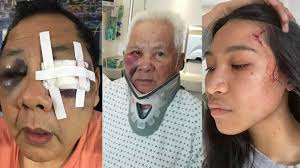 Anti-Asian sentiment has grown significantly since the start of the COVID-19 pandemic. In New York City where I live, attacks against Asians both young and elderly are brutal. Almost every day there is a news report about an Asian person being attacked or harassed. Here are just a couple.
Anti-Asian sentiment has grown significantly since the start of the COVID-19 pandemic. In New York City where I live, attacks against Asians both young and elderly are brutal. Almost every day there is a news report about an Asian person being attacked or harassed. Here are just a couple.
In New York City, a 65-year-old Asian woman on her way to church was knocked to the ground and repeatedly stomped on in broad daylight as two building employees watched and did nothing to assist. They were ultimately fired. Another incident occurred on an NYC subway train (one of many). An Asian male was attacked, pummeled multiple times, put into a headlock until he was unconscious. The attacker then banged the guy’s head on the railing causing his lifeless body to fall to the floor. Again, there were onlookers who did nothing. Let me add that someone did catch the occurrence on camera.
Asian Americans in New York City represent the largest Asian-American population of any city in the United States. Traveling through the city each day, I can understand the hesitation of being a Good Samaritan. Now, when I’m on the train, anxiety builds up in me when I’m in a car with Asian people. I have a fear of what could happen and better yet, what I would do if something did happen.
These hate crimes are not limited to NYC. 140 hate incidents have been reported against Asian Americans across Maryland, Virginia, and D.C. since March 2020, according to a new report by Stop AAPI Hate. The group, which formed at the start of the pandemic to fight the rise in racist attacks against Asian Americans, counted 3,795 such hate incidents across the country.
Together We Must Stand
We as people of color are in turbulent times and must work together to form cross-racial unity. In the wake of the March 16, 2021 violence in Atlanta where a man went on a violent shooting spree, attacking and killing people at three spas, six of the victims Asian; Black, and Asian communities have come together. Uniting towards a common goal to combat racism. The violence perpetrated against Asian individuals has further sparked both a sense of heightened activism from within the Asian-American community and broad-based support from beyond; for one, the Black community. In the wake of the Atlanta killings, many have rallied in support of the Asian American community, producing a palpable sense of unity in the fight against anti-Asian violence. However, in the past, this support was not always the case.
The history of Black and Asian relations in the U.S. is fraught. Anti-Black racism has existed in the Asian community; anti-Asian racism has existed in the Black community. This dynamic of one community of color being pitted against another must cease. What was once what some considered being subtle hate has now become more prominent in the way of open hate. In calling for systemic change and organizing around public hate crimes and deaths, Asian American leaders said they’re taking cues from the Movement for Black Lives coalition, as well as from Muslim and Asian activists who dealt with Islamophobia after 9/11. What may be a little-known fact to many, including me, is that Black and Asian relations have their roots in various Black movements.
Black Civil Rights Movement has Long Inspired Asian Leaders
While a renewed sense of unity between communities of color could prove fruitful in terms of cross-racial organizing, such coalitions and cooperative efforts have existed since the civil rights era. Jakobi Wi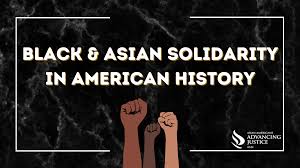 lliams, an associate professor of African American and African Diaspora studies at Indiana University, noted that members of the Asian and Black communities have cooperated on social justice efforts since the civil rights movement of the 1960s.
lliams, an associate professor of African American and African Diaspora studies at Indiana University, noted that members of the Asian and Black communities have cooperated on social justice efforts since the civil rights movement of the 1960s.
Yuri Kochiyama, a Japanese American woman from New York City became one of Malcolm X’s closest friends and ally after meeting him at a protest in New York City. Civil Rights leader Richard Aoki in Berkley, California, was among the Black Panther Party’s earliest members and the only Asian-American to hold a leadership position with the group. Activist Grace Lee Boggs, of Chinese ancestry, devoted her life to bettering life for Black-Americans. Asian-American activist groups like Yellow Brotherhood and East Wind took organizational cues from the Black Power movement.
Black and Asian present relationships rooted in the past, advances more opportunity for the groups to connect nationally and strengthen their reach and influence now. Let’s take a brief look at both Black Lives Matter and Stop Asian Hate movements and their cause to foster change.
Black Lives Matter Movement in Retrospect
The Black Lives Matter movement started on July 13, 2013. It was founded by Alicia Garza, Patrisse Cullors, and Opal Tometi. The movement aims to end systemic racism, gun violence, and police brutality against African-Americans. Since the acquittal of Trayvon Martin’s killer in 2013 and the killing of Michael Brown in Ferguson, Missouri, in 2014, the phrase “Black Lives Matter” has become a rallying cry for a new chapter in the long Black freedom struggle. People of all ages have taken to the streets in protest for a righteous cause, especially our young people who deserve and demand to be heard.
Stop Asian Hate Movement – The Now
Likewise, the Asian community and the Stop Asian Hate movement align with similar goals. Stop Asian Hate has similarly advocated for ethnic studies curricula as a means to curtail bullying, as well as community-based violence protection programs to protect the elderly, and the expansion of civil rights protections to end harassment in business.
In an interview with USA Today, executive director Stephanie Cho of Asian Americans Advancing Justice-Atlanta said that in Atlanta, where the slayings took place, the disconnect between the Asian-American community and police became strikingly clear in the aftermath with Law enforcement reporting the shootings were not race-driven. Ask yourself – how familiar are these words? Cho’s office called on state and local leaders to boost crisis-intervention resources in addition to dealing with the root causes of race-based violence and hate.
Younger generations of Asian- Americans are doing their part by taking to the streets. In Oakland, San Francisco, and New York, they’re helping to provide alternatives to heavier law enforcement by accompanying elderly community pedestrians as a safety measure. Maddy Park, an Asian-American New Yorker raised $100,000 to keep Asian-Americans safe by paying for their Uber rides so that they don’t have to worry while taking public transportation.
Black/ Asian Solidarity – Keeping the Momentum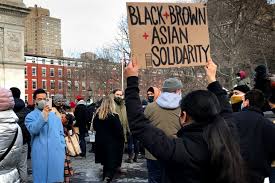
COVID-19, although a monster in itself, is not the culprit here. It’s racism that continues to manifest itself over and over again. It’s the root of all evil! As the battle is being fought against a foe that is common among both groups, we need to consider ways of how we can work together on the issue of hate crimes and make sure our communities stop being targets.
BLM and Stop Asian Hate are critical movements and an essential need to affect change. But, like all movements, if the fight doesn’t continue, it potentially could lose momentum. We need to start thinking about how our struggles are related and intertwined and tackle the core of the problem. Granted, many struggles are rooted in bigger issues that are not easy to fix. However, solutions need to be created that are not band-aid solutions to individual incidents.
This moment is rich with opportunity. Solidarity is now. No more muting the message against hate. BLM is lending its voice to Stop Asian Hate, sparking a positive movement. Let’s you and I do our part. Build community. Ask your networks, organizations, places of worship to make solidarity statements. Create/Sign petitions for reforms and accountability for egregious racially motivated crimes. Stand together against systemic racism and the societal constructs that support them. It’s a lens that makes clear why we all have to pull together.
Hate continues to run rampant and there’s still a lot to work to be done. Whether people will continue to build and nurture this alliance after the vigils and the marches wind down and the outrage over the attacks in Atlanta subsides, is another matter. I’d like to say yes.
Closing Statement
It will be interesting to see what role the White House will play in having Asian representation in high-level positions. Granted, President Biden has made some strides in his plan to diversify his staff. However, the White House could still do better. While Vice President Kamala Harris is of Indian descent, there are no Cabinet secretaries of Asian American or Pacific Islander descent in Biden’s administration despite the president’s pledge to reflect the nation’s diversity.











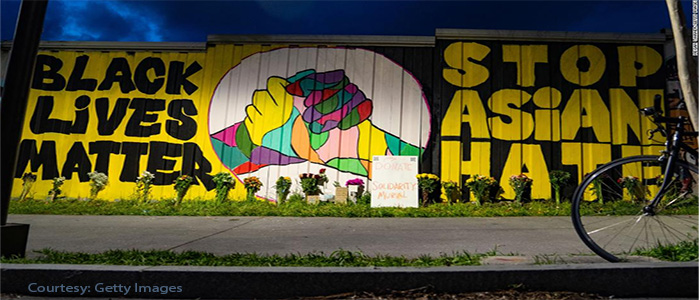
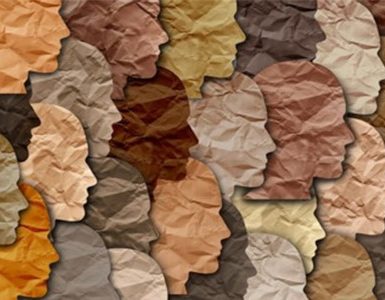
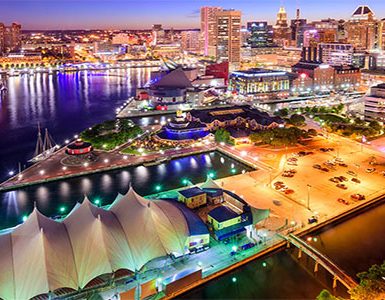
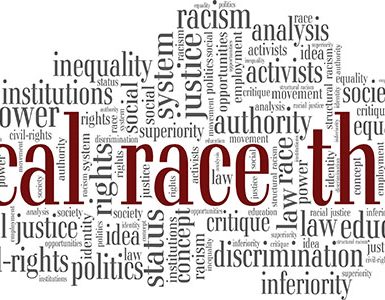



Add comment